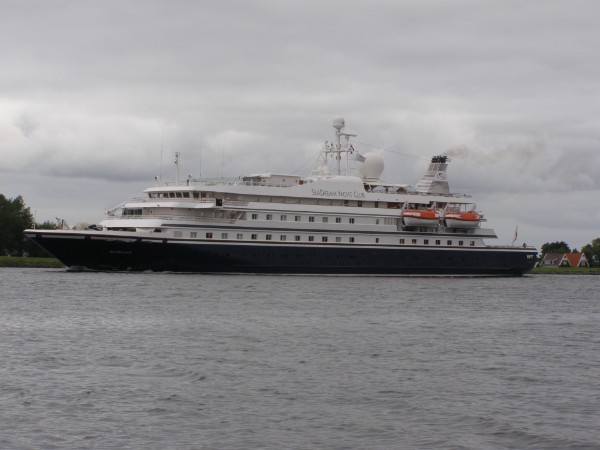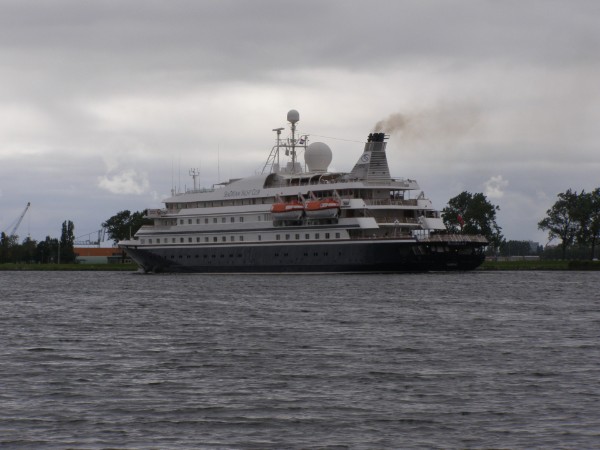Sea Dream 1

In the first years of the 1980's, when Norwegian Caribbean Lines had introduced the rebuilt France of 1960 as Norway, the largest cruiseship in the world, other cruiselines started to begin thinking about upscale cruiseliners too. Carnival placed an order for eight 70.000-plus ton cruiseliners, Princess Cruises ordered the 40.000-ton Royal Princess and others followed soon. But next to these at that time giant cruiseships, other companies concentrated on smaller, luxurious ships, more in the style of private yachts. One of the first companies to do so was, of course, a Norwegian company named Sea Goddess Cruises, part of Norske Cruises. They had ordered a couple of 4.253-ton yachts from the famous Wärtsilä Shipyards in Helsinki, Finland, although it was first planned to built a series of eight of these ships, for an amount of 2,5 billion US-dollars. The ships would have a lenght of 104,81 meters, a width of 14,61 meters and their draft was 4 meters. Their passenger capacity was 116 and these were cared for by 95 crewmembers. This states the immense luxury found on these ships. These twin-screw diesel powered ships reached a speed of 17,5 knots, quite modest, but good enough for the kind of passenger that had to be attracted to them. The first ship was launched in 1984 under yardnumber 466 and was named Sea Goddess 1 and the second ship was completed in 1985 as Sea Goddess II under yardnumber 467.
The ships were built to offer their wealthy passengers ports of call unable to be visited by larger ships in a very personalized atmosphere. As a little sneer to the mass-market cruiselines of the time, Sea Goddess Cruises stated that they were serving a very 'affluent and discriminating section of the market that had been ignored by other cruiselines seeking to attract more passengers from the mass market'. Great care was taken for the personal wishes of the guests so it was common for the crew to try and find that special bottle of champagne for one of the guests in one of the ports visited. The ships sailed the Mediterranean and the Caribbean, often calling at ports like Portofino, Monte Carlo and Capri. The fares for these voyages were the highest in the world, starting from 627 dollars a day. The ships were called the most luxurious ships ever to sail and staterooms came with a full sitting room that was easily to be converted to a private dining salon, a caviar- and salmon filled refrigerator and a bar that was filled with the favorite drinks of the guest, that was inquired for before the cruise started. Also, the staterooms all had their own private library, stereo and video systems and spacious closets. The ship itself feautured a main salon, an outdoor pool, an outdoor café, several bars, a beauty salon , gift shop and casino. But also, there was a unique tailgate at the stern, that could be lowered to give easy access to the water for watersports or swimming. Also, sailboats and twin-sailboats could be provided. The aft part of the funnel was decorated with a waterfall for the right atmosphere.
Passengers could dine in their own private dining salon, but the ship also had a resataurant where the meals were cooked to order and in the specific tastes of the individual passenger. All wines and champagne were included in the fare, so passengers did not have to worry about high bills at the end of the cruise. This was, and still is, no standard in cruising.
Operations started in 1986, and from october of that year, Sea Goddess I was chartered for around five months as a review and hotelship for the America's Cup races and for this, she was stationed at Perth, Australia. But the 1980's were financially not a very good decade. So the two ships made enormous loss and after just one season, Sea Goddess Cruises was in such financial bad weather that the ships were to be reposessed by their Finnish builders and the company had to cease its services. But before the ships were going to be back in Finland to await a new buyer, Cunard Line cleverly stepped in and arranged a twelve year charter of both ships, to be fully integrated into the Cunard brand. The thought was that under the well-known name and financial backing of the great Cunard Line, the ships could sail at profit. And Cunard Line of course became the operator of the two highest rated cruiseships in the world. The ships did not recieve a traditional Cunard name, on the one hand this was better because they were very different from the ships that Cunard had operated in the past so Aquitania or Caronia would have been a bad choice for renaming these ships. On the other hand, Cunard Line was by no means a company that could be seen as one. There were the two Norwegian twins Sagafjord and Vistafjord sailing under the Cunard-NAC banner, there was the Queen Elizabeth 2 as the traditional Cunard liner and then there were the more modest Cunard Countess and Cunard Princess. The addition of the Sea Goddesses, that were managed under the name of Cunard-Sea Goddess Cruises, made the company into a complex structure that tried to get a grip in almost every part of cruising, but not excelling in one particular.

Besides this, the marketing that Cunard did to both Sea Goddesses was not bad and the ships started to get their first glimpses of succes. Their names became well known within the cruising industry and they kept sailing their intended regions under the Cunard Line banner untill 1998. In this year, Cunard Line was restructured by their new Norwegian owners Kvaerner, just prior to the sale of Cunard Line by Kvaerner to the large Carnival Corporation. Sagafjord and also Cunard Princess and Cunard Countess were sold. Royal Viking Sun, that was another addition to the Cunard fleet from the beginning of the 1990's onwards, and both Sea Goddesses were transferred to Seabourn Cruise Line. This company, headed by Atle Brynstead, sailed with three highrated cruiseyachts at that time and doubled in size due to this transfer of ships. The ships were renamed Seabourn Goddess I and Seabourn Goddess II. At the time Seabourn and Cunard Line started working together as Cunard Line Limited, Brynstead became chairman of Cunard Line and later on he also became a member of the board of directors of Carnival. In 2001, he formed his own company Sea Dream Yacht Club and he aquired the both Seadream Goddesses for this purpose. The ships were renamed Sea Dream I and Sea Dream II and their cruises were marketed under the slogan 'It's yachting, not cruising'. The ships were updated for the new company, and they are still rated with five stars now, quite remarkable after 25 years of service.
The pictures were taken near Spaarnwoude at the Northsea Canal in The Netherlands at the 30th of july 2011.

